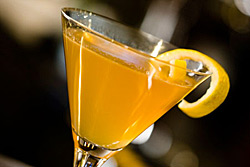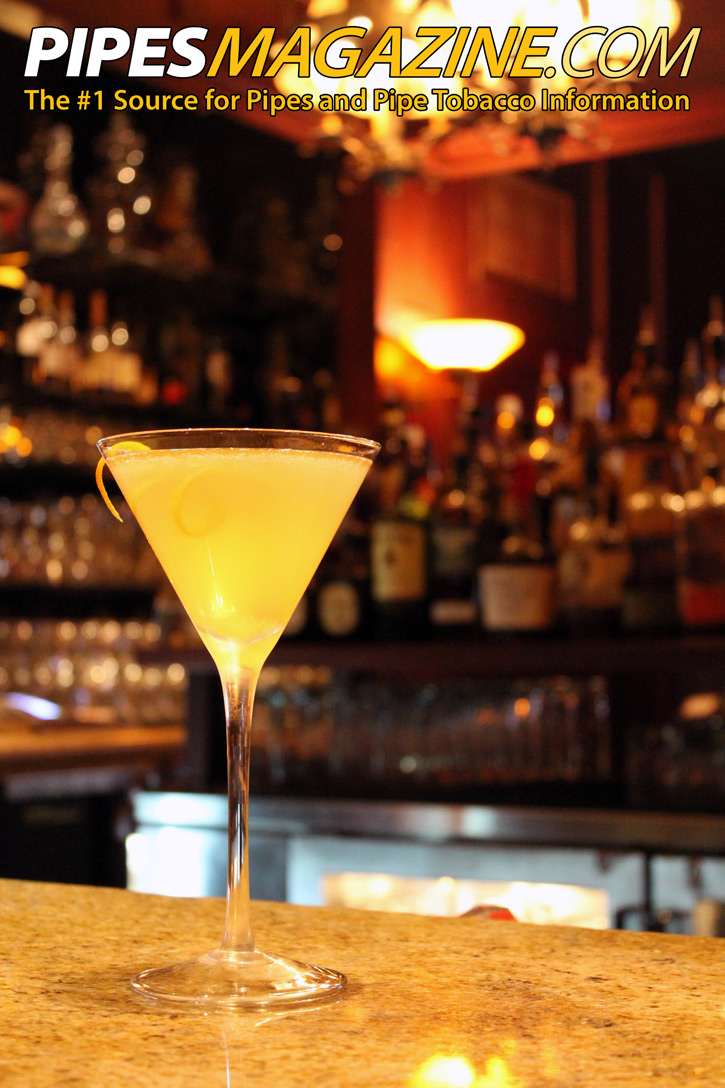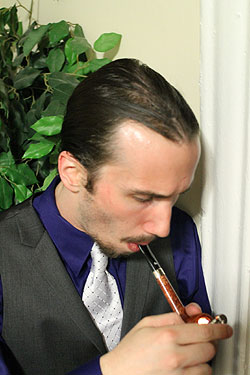Ethan Brandt
 The period informally known as the Prohibition Era was a terrible time in American history: the mob gained power, otherwise law abiding citizens were arrested for illogical reasons, and a number of businesses went under as a result. It seems we didn’t learn too much from history, looking at how tobacco is currently being treated in the United States and in many places around the globe, but I digress…
The period informally known as the Prohibition Era was a terrible time in American history: the mob gained power, otherwise law abiding citizens were arrested for illogical reasons, and a number of businesses went under as a result. It seems we didn’t learn too much from history, looking at how tobacco is currently being treated in the United States and in many places around the globe, but I digress…
Some good did come out of Prohibition. Bartenders manning speakeasies had to become more creative with their creations: supplies were limited, demand was high, and quality of the product often left much to be desired.
Without question, one of the best creations to come out of the Prohibition era is the Sidecar, a classic cocktail with a classic name that is far too often neglected these days.
Unlike the previous two cocktails we’ve discussed in this column, the Old Fashioned and the Hot Toddy, the approximate date of origin for this cocktail is rather well established: while we might not know the exact year – some sources say 1920, but this seems too clean, considering Prohibition did not begin until that year – we can at least be certain that the drink was invented during Prohibition, between 1920 and 1933.
According to legend, the Sidecar was invented in Harry’s New York Bar, by the owner himself, and earned its name from the motorcycle sidecar in which Harry was frequently transported to and from work.1
Also unlike the previous two cocktails, the recipe for the Sidecar comes without too many variations. As Doug Quinn of P. J. Clarke’s described, the Sidecar is "two parts strong, one part sweet, one part sour" and thus "adheres to the Pythagorean formula of a classic cocktail."2 Personally, I’d never heard of such a formula, but Quinn convinced me through his description. According to some, there is a little debate as to what the best proportions are. While Quinn is clearly a fan of the following proportions, the "French school" recommends equal amounts of cognac, lemon juice, and Cointreau. Try both out and let us know what you think!
Also, as a confession, the research for this article was the first time I had truly tried a Sidecar.
For those following along at home, the basic formula for a Sidecar is as follows:
- 1.5 ounces cognac (Hennessy VS being the frequently preferred variety)
- .75 ounces Cointreau (though any Triple Sec would do in a pinch)
- 1 squeeze of lemon juice
- Optional: 1 squeeze of orange juice
- Place all ingredients in a cocktail shaker with ice, shake, and strain
- Garnish with an orange twist, ideally flamed (the process is rather simple for a flamed garnish – simply twist a thin portion of orange rind over a flame, such as a candle. This helps to release the aromatic oils within the rind and it makes you look cool.)
- Serve in a Cocktail glass (Martini glass)
My first stop, as I am want to do when it comes to classic cocktails, was to hit up Taste, a small restaurant and bar a short walk from my house known for its respectful renditions of the classics. The bartender quickly made up a Sidecar without any hints of orange, even being served with a lemon garnish instead of orange. The tart from the lemon juice was front and center on my palate, which makes sense considering the origin of the cocktail. In all likelihood, the alcohol that was available was far from the highest quality during Prohibition and the tart lemon juice was thus helpful in covering up any lack of quality. The cocktail was refreshing and lovely. It would have been even better on a hot summer day instead of the coldest day of the year so far.
My next stop was my family’s restaurant, Nathalie’s, where my brother frequently tends bar. The first version I was served here made use of sour mix instead of the lemon juice and was served with a nice, twisted orange peel garnish. The sour mix resulted in a far less bracing taste and allowed me to appreciate the cognac more. Upon tasting this version, I realized that the lemon in the first version practically covered up all of the flavors of the cognac, which was a shame. Aside from being able to notice a little bit more of the cognac, the flavor was rather similar.

Sidecar at Nathalie’s in St. Louis, MO. Photo by Ethan Brandt
Before I left, however, my brother recommended a more unusual version: a Sidecar with pineapple juice replacing the lemon juice. I was hesitant at first, but the sweetness of the pineapple juice actually allowed the cognac a little bit more room to play. The flavor was slightly nuttier and had a little bit more depth than the classic version. With a sugared rim, this version would be sure to please any cocktail drinker.
Perhaps the biggest challenge of this cocktail was finding a tobacco to pair it with that complimented both the tobacco and the drink. At first, I tried a sweeter aromatic, Bagpiper’s Dream by Rattray. The sweetness of the tobacco, however, made my tongue less sensitive to the sweetness from the Sidecar, resulting in the cocktail tasting more tart that it is intended. I also noticed that the Sidecar made it difficult for me to detect the usual nuances of a Virginia blend.
Eventually, I found a winning combination: Sidecar and McClelland’s Dominican Glory, though likely any cigar leaf blend would work. The cigar leaf packed enough of a punch to cut through the tartness of the lemon juice, but was different enough in flavor to not conflict with the subtlety of the cognac or interfere with the sweetness.
The Sidecar is definitely a winning drink, especially if one is looking for a way to take a break from the bourbon, vodka, and gin drinks while still looking classy. So, what are your thoughts on the Sidecar? Do you have a favorite preparation technique or tobacco to go alongside it? Sound off below and thanks again for reading!
——————————————-
1. The Unofficial Mad Men Cookbook, by Judy Gelman and Peter Zheutlin.
2. Id

Ethan Brandt is a second-year Law student at Washington University in St. Louis, focusing primarily on Constitutional Law. He has a blog all about pipes called Pipe School and has had pipe-related pieces published at Smokingpipes, Quality Briar, and works closely with The Briar Portrait Gallery. He picked up his first pipe his freshman year of college and never looked back. |



















Oh man, I remember drinking sidecars when I was about… well a little before it was legal for me. I was dating a girl in the mid 60s whose dad loved to mix cocktails, and had no problem making us drinks as long as we didn’t go out afterwards. He made them with cognac, triple sec, and lemon, but always rimmed the glass with lemon and dipped it in powdered sugar before pouring the drink. They were so good, but he never made us more than two. (smart on his part) I’ve tried ordering these in a few bars over the years, but some bartenders didn’t know what they were, and others never used the sugar. Might have to get some fixins and do my own sometime.
What a grand drink.
I spent the 80’s pouring classic cocktails at a wonderful chop house in my hometown. I learned from bartenders well into their 80’s and had a ball mastering Manhattans, Old Fashioneds, Daiquiris, Gimlets, Martinis – plus stocking a variety of stuffed olives for particular & preferred customers – various Alexanders and a host of heavily creamed after dinner drinks, a slough of Rickeys, Cobblers, Daisys, Fizzes & Bucks and even learned to layer a better than passable Pousse Cafe.
I think I better break out the cocktail shakers this weekend and ratchet up our sons’ knowledge of beverages beyond bttls. from a micro-brewery.
Fnord
One man’s lemon squeeze is another’s cocktail disaster and thus when sharing recipes I always try to make sure I know the exact amounts
Below is a Sidecar recipe from Death and Co’s latest book. In 2008 Death & Co won Best Cocktail Bar in America and World’s Best Cocktail Menu at Tales of the Cocktail, the world’s premier cocktail festival:
SIDECAR
“2 OUNCES PIERRE FERRAND 1840 COGNAC
½ OUNCE COINTREAU
¾ OUNCE LEMON JUICE
¼ OUNCE CANE SUGAR SYRUP ( 2 cups Sucanat / Evaporated Cane sugar to one cup water )
GARNISH: 1 ORANGE TWIST
Shake all the ingredients with ice, then strain into a coupe. Garnish with the orange twist.”
Recipe excerpted From: David Kaplan, Nick Fauchald, and Alex Day. “Death & Co.” iBooks. https://itun.es/us/BhvzZ.l
Now I’ve got to find myself a sidecar with pineapple juice. That sounds delicious!
Sounds tasty but I’m a Bourbon and Coke devotee.
And I no longer visit bars at my age and since smoking is no longer allowed.